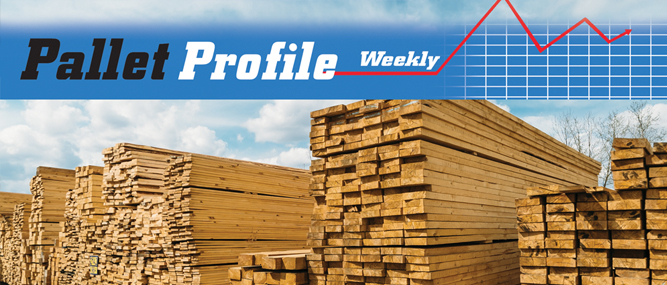About two years ago, I came on board here at Industrial Reporting as the market analyst for the Pallet Profile, to try and help fill a very big void and some very large shoes. Those shoes belong to long-time friend Jeff McBee. Jeff and I had been friends for about 25 years, not within the pallet business, but within the music world, as we were both musicians and fellow guitar players. My knowledge of the pallet business came from stopping by and spending time talking with him and Scott Brindley on many occasions. Little did I ever know I would be filling his place one day. But here I am, and it has been a great and interesting journey so far. As Ed Brindley has told me though, “Boy, you came on at some very interesting and volatile times in the wood industry!” So, let’s dive right in and share what we have seen going on in this crazy market!
Since last year the hardwood and softwood lumber markets have been in frenzied whirlwind. With the failed Softwood Lumber Agreement, unusually wet climate in many regions, including warmer than usual winters, new trucking regulations, an increasingly difficult labor situation, and an increase in aggressive buying of low-grade materials from railroad and road/crane mat industries, pallet manufacturers around the country are doing everything they can to survive the current state of affairs. Oh, and let’s not forget to add the increased volume of wood being exported as well.
Since the beginning of 2018, we have seen some of the most aggressive upward pricing pressure on raw materials that the industry has seen in the last four years. And recent indicators from contacts around the country are not showing any signs of relief in sight. With all of the various factors coming into play at seemingly the same time, as one major manufacturer stated, “it’s the perfect storm” of the wood industry.
Extreme weather conditions have played a huge factor since the late summer and early fall of 2017. For a period toward the end of 2017, much of the country experienced extremely cold sub-freezing temperatures and not a lot of moisture associated with it. Everyone thought this was going to be ideal for the logging companies to finally get into areas that had been impassable from the deluge of summer rains and now had frozen over. And for a short while, it was. But it was short lived as 2018 came rolling in, and with it unusually warmer temperatures and rains, turning logging roads into mud bogs again, and bringing logging to a halt in many areas. It couldn’t have happened at a worse time as we start to gear up for the spring season and pallet demand typically starts to significantly increase.
There has also been an increase of low-grade lumber being purchased by the rail tie and road/crane mat industries. With the new natural gas line going in from Pennsylvania down to the Chesapeake, those companies are purchasing large amounts of lumber and have the deep pockets to pay mills whatever the asking price may be, pushing the price of lumber in the Mid-Atlantic and surrounding regions to what could become record highs and making lumber availability extremely tight for the pallet industry. The effect of the lumber shortage is being felt as far west as Iowa and down into the deep South as pallet manufacturers reach further out to obtain materials to keep up with orders.
Another factor we mentioned earlier is the increased amount of logs being exported to China recently. Selling lumber to China and other foreign countries may not be anything new, but recent reports have indicated that the amount of lumber being exported over the last six months or so has increased significantly, and again being sold at prices most pallet manufacturers can’t compete with, adding to the already tight availability situation.
Labor in the pallet industry has been and remains one of the top issues for nearly all manufacturers. And with 2018 many states saw minimum wages increase, forcing employers to not only pay higher starting pay for workers, but then increase the pay of those who may have years of time with the company. Many pallet business owners have been offering higher wages in hopes of keeping good skilled laborers on. But even then, it is a struggle to find that handful willing to show up every day and stick it out for the long term.
Even though the lumber supply chain is seeing some of the tightest conditions it has experienced in quite some time, and prices are reaching levels that haven’t been seen in years, pallet demand continues to be strong in most markets, for both hardwood and softwood. And one positive side is that this could be the opportunity for many pallet manufacturers to finally increase pallet prices to what they feel are fair prices in an industry where customers always seem to want better and better for less and less.
If you would like to keep up in more detail with the pallet and lumber industry, subscribe today to the Pallet Profile. It is the best weekly resource for news and information on the pallet industry, call 804-550-0323 or subscribe at www.palletprofile.com.




